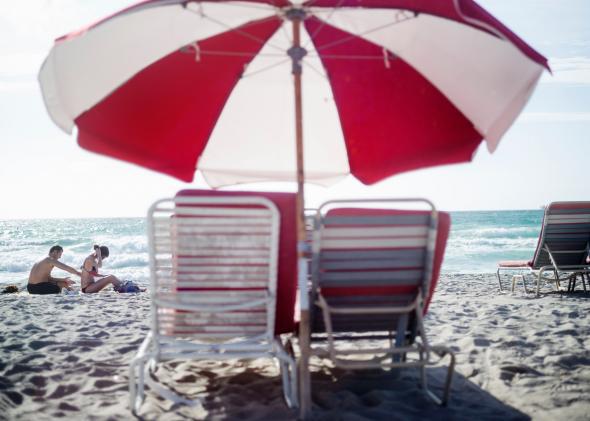It’s the peak of hurricane season, and right now, meteorologists are tracking only one tropical system on Earth.
Over Labor Day weekend, there were exactly zero tropical cyclones anywhere in the world—a very rare late-summer respite. (1500 GMT on Aug. 29 to 2100 GMT on Sept. 1—78 total hours—to be exact, according to data compiled by University of Miami meteorologist Brian McNoldy.) It’s been several decades since there’s been such a lull on the first day of what’s normally the season’s most active month:
Since then, the tropics have picked up just slightly. The single storm currently plying the world’s oceans is Hurricane Norbert, forecasted to make a close brush with Mexico’s Baja Peninsula over the next few days and possibly bringing some soaking rains to the drought-stricken deserts of California, Nevada, and Arizona next week. And that’s it. For the whole planet. In a normal year, there’d be as many as six or eight.
Typhoons (Asia), hurricanes (Americas), and tropical cyclones (India/Australia) are place-based names for the same phenomenon—swirling masses of thunderstorms typically hundreds of miles across that derive their energy from warm tropical waters. These storms are primarily ranked in categories according to their maximum wind speed near the center, no matter their size or potential for heavy rainfall. Still, the ferocity of Sandy and Irene prove that it doesn’t always take a storm with high wind speeds to cause widespread destruction. Sandy has helped motivate a change to the National Hurricane Center’s warning philosophy, with greater attention now given to coastal surge flooding and storms that don’t fit classical hurricane definitions.
The last Pacific tropical system disintegrated exactly a month ago, on Aug. 4, not that the storm-weary Philippines is complaining. Before Hurricane Arthur’s July 3 landfall, the U.S. mainland had gone nearly two years since its last direct hurricane strength strike. It’s been much longer since a major hurricane came ashore—exactly 3,237 days (more than nine years) since Hurricane Wilma hit Florida in October 2005. That is by far the longest streak since American recordkeeping began and has generated a flood of debate (pardon the pun) in the media.
This year’s North American lull can be partially attributed to weak El Niño conditions, which tend to suppress storm activity in the Atlantic. Overall, global tropical cyclone activity is not down as drastically, only about 93 percent of average, driven primarily by a string of especially strong storms between Hawaii and Mexico.
We know that the lengthy streak between American hurricane disasters will eventually end, and when it does, it probably won’t be pretty. MIT atmospheric scientist Kerry Emanuel has demonstrated that the frequency of the strongest hurricanes should increase with warming seas in the coming decades (PDF), and separate research has shown those storms will likely take paths further north than in decades past, though these findings are still an area of active research. All the while, Americans continue to flock to the coasts even as sea levels continue to inch upward.
There’s no American city more vulnerable to this trifecta of stronger storms plus rising seas plus population influx than Miami.
“We’re overdue,” said Miami meteorologist John Morales. I reached him by phone earlier this week.
Morales recently recorded a PSA for the World Meteorological Organization that focuses on the threat of future hurricanes in Miami in advance of this month’s United Nations climate summit in New York City (a city that, of course, has its own hurricane problem (PDF) to worry about).
South Florida’s coming climate woes have been much discussed lately, most notably via a Rolling Stone article last year that imagined a future, floating Miami. More recently, the local press has fretted about falling real estate values and the city’s insurability while state officials continue to look the other way.
When you overlay the city’s relatively fortunate recent hurricane history with its surging demographics, the future looks especially ominous:
South Florida hasn’t had a direct strike by a major hurricane since Andrew in 1992. On average, long-term records show a major hurricane hitting the region every 17 years or so, but there were three between 1960 and 1965. Since Andrew, the economy in South Florida has boomed. According to the OECD (PDF), Miami now has the largest exposed coastal assets of any city in the world.
“Tremendous growth is visible everywhere you look in the city today,” said McNoldy, via email. “The longer a location goes without a significant landfall, memory fades, new people move in, and infrastructure gets built up, unchecked by nature’s forces. [Miami today] is a dangerous combination of inexperience and complacency.”
Morales cited a recent study that said a repeat of the 1926 Miami hurricane today would cause $125 billion in damage, more than Katrina, and double that of Sandy. It would be the country’s worst ever natural disaster. Yet, the housing boom continues: “Just in the last two years, tens of thousands of more units are being built right on the water.”
For someone raising a family in South Florida, like Morales, this isn’t an abstract problem. As a scientist, he knows that Miami’s days are numbered. “Would I advise my son to buy property on Miami Beach? No, I’d advise him against it.”
Sometime in the next few decades, a Hurricane Andrew-like storm is going to hit South Florida, and it will prompt the inevitable line of questioning: what do we do with Miami? Do we rebuild or do we retreat? And after that storm, another one will hit. And another.
As Morales puts it, “You know in the back of your mind, be it in 10 or 50 or 80 years, we’re going to face that type of dilemma.”
For Morales, despite all the warnings he relays, he sees a disconnect. “People in the news know about it but don’t worry about it, people on the street don’t even know about it.” Morales continued, “How do you get to people and make them be concerned about something they just can’t wrap their heads around?”
